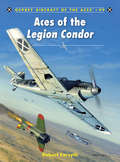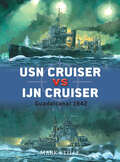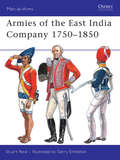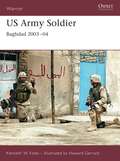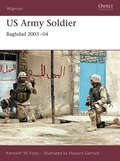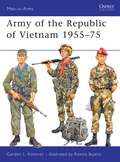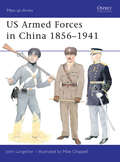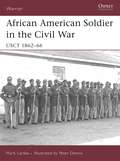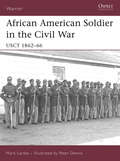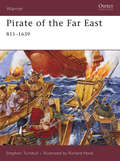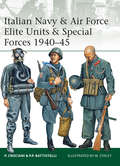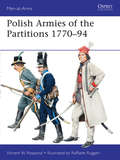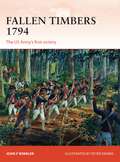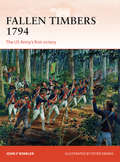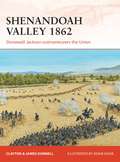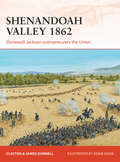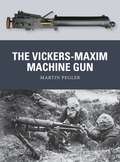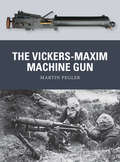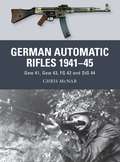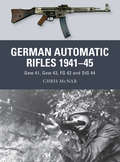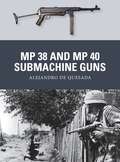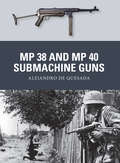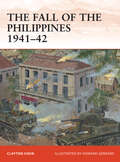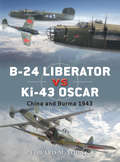- Table View
- List View
Aces of the Legion Condor (Aircraft of the Aces #99)
by Jim Laurier Robert ForsythFor Germany, the Spanish Civil War proved a perfect testing ground for new technologies and tactics. During the war, some 19,000 German 'volunteers' formed an aviation group called the Legion Condor in support of the fascists. Originally flying He-51s, they were soon upgraded to 109s. These fighters proved dominant in the Spanish skies, and many members of the legion scored five or more kills during the fighting.
USN Cruiser vs IJN Cruiser: Guadalcanal 1942 (Duel #22)
by Mark StilleAlthough the war in the Pacific is usually considered a carrier war, it was the cruisers that dominated the early fighting. This thrilling duel presents the cruiser clashes during the battles for Guadacanal , highlighting the Battle of Savo Island and the Battle of Cape Esperance. The first was a Japanese victory that resulted in the loss of four Allied cruisers. However, in the latter, the Americans managed to turn the tables despite the battle being fought throughout the night. This book presents a view of the design and development of the opposing weapons systems, illustrated with newly commissioned digital artwork. It uses firsthand accounts to bring the battles to life and explain why the Americans suffered early on, but eventually had their revenge.
Armies of the East India Company 1750–1850 (Men-at-Arms #453)
by Gerry Embleton Stuart ReidContrary to popular belief, the capture of India was not accomplished by the British Army, but by the private armies of the East India Company, which grew in size to become larger than that of any European sovereign state. This is the history of its army, examining the many conflicts they fought, their equipment and training, with its regiments of horse, foot and guns, which rivalled those of most European powers. The development of their uniforms, which combined traditional Indian and British dress, is illustrated in detail in this colourful account of the private band of adventurers that successfully captured the jewel of the British Empire.
US Army Soldier: Baghdad 2003-04 (Warrior)
by Howard Gerrard Kenneth W EstesIn April 2003, after brief combat, Baghdad fell under US control and the Coalition Provisional Authority was formed to maintain order until a new Iraqi government became a reality. This book details the stabilization operations and the experiences of US Task Force 1st Armored Division (TF 1AD), whose soldiers lived and fought under extreme conditions and whose activities were center stage in the controversial debate surrounding the initial occupation of Iraq. Soldiers' personal experiences from recruitment, training, and armed combat to their aftermath and effects emerge from interviews and new documentation by author Kenneth W. Estes in his account of this crucial military campaign.
US Army Soldier: Baghdad 2003-04 (Warrior #113)
by Howard Gerrard Kenneth W EstesIn April 2003, after brief combat, Baghdad fell under US control and the Coalition Provisional Authority was formed to maintain order until a new Iraqi government became a reality. This book details the stabilization operations and the experiences of US Task Force 1st Armored Division (TF 1AD), whose soldiers lived and fought under extreme conditions and whose activities were center stage in the controversial debate surrounding the initial occupation of Iraq. Soldiers' personal experiences from recruitment, training, and armed combat to their aftermath and effects emerge from interviews and new documentation by author Kenneth W. Estes in his account of this crucial military campaign.
Army of the Republic of Vietnam 1955–75 (Men-at-arms Ser. #458)
by Ramiro Bujeiro Gordon L. RottmanEvolved from the colonial units created by the French, this book discusses the original reorganization of these forces into the first national army. Complete with a detailed history of the command structure and orders of battle, the author also sheds light on the little known divisional histories of the army through rare, original source material. Moreover, the author examines in detail the evolution of such key units as armoured forces, ranger commands as well as combat unit organisation. This together with a detailed analysis of the experiences of the typical rank and file soldier as well as officer corps provides a concise and detailed history of an army that is too often neglected or quickly judged.
US Armed Forces in China 1856–1941 (Men-at-Arms #455)
by Mike Chappell John LangellierThis volume reveals the little-known story of the 90-year presence of American forces in China until the fall of Peking in 1941. Included is coverage of the first operations on the Pearl River in 1856 as well as US involvement in the Boxer Rebellion of 1900. As China entered a chaotic period in her history, known as the years of the "Warlords†?, American marines also participated in numerous small-scale amphibious landings. Finally, during the later Sino-Japanese War and early into World War II, US volunteers of the "Flying Tigers†? became renowned for their combat missions in support of Chinese Nationalist forces, and their aerial duels are also recounted by the author John P. Langellier, who has spent several years researching the subject in the US and China. Discover the history of these various actions and the different services involved, recreated in color artwork and illustrated with rare, previously unpublished photographs.
African American Soldier in the Civil War: USCT 1862–66 (Warrior #114)
by Peter Dennis Mark LardasApproximately 200,000 African Americans fought for the Union during the Civil War. Initially, many white soldiers doubted their bravery and skill; they were soon proved wrong. The United States Colored Troops performed countless acts of courage, most famously at the battle of Fort Wagner where the 54th Massachusetts marched forth and scaled the parapets, only to be driven back in fierce hand-to-hand combat. Through fascinating first-hand accounts, this title examines the journey of the African American from slave to soldier to free man, ultimately providing a fascinating insight into the impact that these brave men had on the war and how it influenced their lives thereafter.
African American Soldier in the Civil War: USCT 1862–66 (Warrior #114)
by Peter Dennis Mark LardasApproximately 200,000 African Americans fought for the Union during the Civil War. Initially, many white soldiers doubted their bravery and skill; they were soon proved wrong. The United States Colored Troops performed countless acts of courage, most famously at the battle of Fort Wagner where the 54th Massachusetts marched forth and scaled the parapets, only to be driven back in fierce hand-to-hand combat. Through fascinating first-hand accounts, this title examines the journey of the African American from slave to soldier to free man, ultimately providing a fascinating insight into the impact that these brave men had on the war and how it influenced their lives thereafter.
Pirate of the Far East: 811-1639 (Warrior #125)
by Stephen Turnbull Richard HookFeared throughout the Far East, Japanese pirates were likened to 'black demons' and 'flood dragons'. For centuries relations between Japan, Korea and China were carried out through a bizarre trinity of war, trade and piracy. The piracy, which combined the other elements in a violent blend of free enterprise, is the subject of this original and exciting book. Stephen Turnbull vividly recreates the pirates' daily lives, from legitimate whaling and fishing trips to violent raids. He explores the bases and castles used by the pirates and uses eyewitness accounts and original artwork to give stunning descriptions of a vicious and brutal life.
Pirate of the Far East: 811-1639 (Warrior #125)
by Richard Hook Dr Stephen TurnbullFeared throughout the Far East, Japanese pirates were likened to 'black demons' and 'flood dragons'. For centuries relations between Japan, Korea and China were carried out through a bizarre trinity of war, trade and piracy. The piracy, which combined the other elements in a violent blend of free enterprise, is the subject of this original and exciting book. Stephen Turnbull vividly recreates the pirates' daily lives, from legitimate whaling and fishing trips to violent raids. He explores the bases and castles used by the pirates and uses eyewitness accounts and original artwork to give stunning descriptions of a vicious and brutal life.
Italian Navy & Air Force Elite Units & Special Forces 1940–45 (Elite #191)
by Pier Paolo Battistelli Piero Crociani Mr Mark StaceyThis volume assesses the formidable Special Forces fielded by Italy's navy and air force in World War II. Italian Navy Special Forces were particularly active and respected in the Mediterranean, where 10th Motor-Torpedo Boat Flotilla used frogmen, 'two-man torpedoes' and explosive ram-boats. The Italian Air Force formed a special commando unit, ADRA, before the 1943 surrender; it was tasked with attacking Allied airfields and communications in North Africa. Men from ADRA and Army paratroopers formed the new 'Folgore' Regiment, which also continued to fight alongside German forces until 1945. In both cases, the pro-Allied Italian forces also formed 'mirror' units to fight alongside US and British forces, including the Recce Squadron 'F'. Featuring rare photographs and specially commissioned artwork, this book tells the story of the little-known elite forces fielded by Italy's navy and air force in World War II, some of whose successors remain in service with today's Italian armed forces.
Polish Armies of the Partitions 1770–94 (Men-at-Arms #485)
by Vincent W. Rospond Mr Raffaele RuggeriThe tragic national epic of Polish history began in these late 18th-century wars. Under Poland's Saxon monarchy, Russia and Prussia constantly meddled in the affairs of the Kingdom. In 1768 a civil war broke out between pro-Russian 'Commonwealth' Poles and 'Confederate' patriots who opposed foreign intervention; Russia intervened directly, and the First Partition followed in 1772. Guerrilla resistance continued, and anti-Russian political moves were snuffed out by a second Russian invasion in 1792. Following a Second Partition between Russia and Prussia in 1793, Poland's national hero Thaddeus Kosciusko led a national uprising against the invaders in April 1794. After remarkable victories against the odds at Raclawice and Warsaw, the patriots were finally defeated by the combined armies of Prussia and Russia at Maciejowice. This led to the Third Partition of 1795, between Prussia, Russia, and Austria, and Poland ceased to exist as a political nation. Featuring specially commissioned full-color illustrations, this is the epic story of Poland's doomed struggle to remain independent in the face of aggression from its neighbours in the late 18th century.
Fallen Timbers 1794: The US Army’s first victory (Campaign)
by Peter Dennis John F. WinklerFollowing the defeat at Wabash, in 1792 the Washington administration created a new US Army to replace the one that had been destroyed. The man chosen to lead it was the famous Major-General "Mad†? Anthony Wayne. Having trained his new force, Wayne set out in 1793 to subdue the Ohio Indians. Wayne faced many of the same problems as St Clair including the logistical and intelligence problems of campaigning in the wilderness, not to mention the formidable Ohio Indians. Wayne faced additional problems including the likelihood that he would have to fight both British and Spanish forces, not to mention an American army led by the celebrated commander George Roger Clark. He also faced an insurrection in western Pennsylvania, "Whiskey Rebellion†?, and a conspiracy led by many of his officers and contractors. Despite all these difficulties, Wayne managed to defeat the Ohio Indians at the battle of Fallen Timbers. This was a decisive defeat that led directly to the Treaty of Greeneville the following year which ended 20 years of conflict between the Americans and the Ohio Indians.
Fallen Timbers 1794: The US Army’s first victory (Campaign #256)
by Peter Dennis John F. WinklerFollowing the defeat at Wabash, in 1792 the Washington administration created a new US Army to replace the one that had been destroyed. The man chosen to lead it was the famous Major-General "Mad†? Anthony Wayne. Having trained his new force, Wayne set out in 1793 to subdue the Ohio Indians. Wayne faced many of the same problems as St Clair including the logistical and intelligence problems of campaigning in the wilderness, not to mention the formidable Ohio Indians. Wayne faced additional problems including the likelihood that he would have to fight both British and Spanish forces, not to mention an American army led by the celebrated commander George Roger Clark. He also faced an insurrection in western Pennsylvania, "Whiskey Rebellion†?, and a conspiracy led by many of his officers and contractors. Despite all these difficulties, Wayne managed to defeat the Ohio Indians at the battle of Fallen Timbers. This was a decisive defeat that led directly to the Treaty of Greeneville the following year which ended 20 years of conflict between the Americans and the Ohio Indians.
Shenandoah Valley 1862: Stonewall Jackson outmaneuvers the Union (Campaign #258)
by Adam Hook Clayton Donnell James DonnellMajor General "Stonewall†? Jackson became a legend for his actions in Shenandoah Valley, Virginia, in 1862. Marching over 600 miles in 48 days, he, along with his army, won five major battles. His forces, never numbering more than 17,000 men, overcame a combined Union force of 50,000, demonstrating his ability to maneuvre his troops and deceive his enemies into believing he possessed the advantage. Charted throughout these pages is the journey leading up to, and including, "Stonewall†? Jackson's final victory, all the while performing better than anyone could have expected. The campaign became a showcase for the mobility and success of Jackson's outnumbered men, who held the larger Union forces pinned down and off balance, consequently allowing Jackson to force march his men to take part in the Seven Days Battles that saved Richmond and gained him victory.
Shenandoah Valley 1862: Stonewall Jackson outmaneuvers the Union (Campaign #258)
by Clayton Donnell James Donnell Mr Adam HookMajor General "Stonewall†? Jackson became a legend for his actions in Shenandoah Valley, Virginia, in 1862. Marching over 600 miles in 48 days, he, along with his army, won five major battles. His forces, never numbering more than 17,000 men, overcame a combined Union force of 50,000, demonstrating his ability to maneuvre his troops and deceive his enemies into believing he possessed the advantage. Charted throughout these pages is the journey leading up to, and including, "Stonewall†? Jackson's final victory, all the while performing better than anyone could have expected. The campaign became a showcase for the mobility and success of Jackson's outnumbered men, who held the larger Union forces pinned down and off balance, consequently allowing Jackson to force march his men to take part in the Seven Days Battles that saved Richmond and gained him victory.
The Vickers-Maxim Machine Gun (Weapon #25)
by Peter Dennis Martin PeglerThe world's first self-powered machine gun, the Maxim gun became a potent symbol of Victorian colonialism in the closing years of the 19th century. It was the brainchild of Sir Hiram Maxim, the American-born firearms inventor who founded the company bearing his name with financing from Albert Vickers, who became the company's chairman; Maxim's company was absorbed by Vickers, Sons and Company in 1897. Subsequent variants in British, German and Russian service – the .303in Vickers (1912), 7.92mm MG 08 (1908) and 7.62mm PM M1910, respectively – dominated both the Eastern and Western Fronts during World War I and soldiered on into World War II, while the Vickers remained in front-line British service essentially unchanged until 1968. Featuring specially commissioned full-colour artwork and written by a noted authority, this is the engaging story of the Maxim and its descendants, the innovative rapid-fire weapons that saw combat with British, German, Russian and other forces in the late Victorian era and throughout the world wars.
The Vickers-Maxim Machine Gun (Weapon #25)
by Peter Dennis Martin PeglerThe world's first self-powered machine gun, the Maxim gun became a potent symbol of Victorian colonialism in the closing years of the 19th century. It was the brainchild of Sir Hiram Maxim, the American-born firearms inventor who founded the company bearing his name with financing from Albert Vickers, who became the company's chairman; Maxim's company was absorbed by Vickers, Sons and Company in 1897. Subsequent variants in British, German and Russian service – the .303in Vickers (1912), 7.92mm MG 08 (1908) and 7.62mm PM M1910, respectively – dominated both the Eastern and Western Fronts during World War I and soldiered on into World War II, while the Vickers remained in front-line British service essentially unchanged until 1968. Featuring specially commissioned full-colour artwork and written by a noted authority, this is the engaging story of the Maxim and its descendants, the innovative rapid-fire weapons that saw combat with British, German, Russian and other forces in the late Victorian era and throughout the world wars.
German Automatic Rifles 1941–45: Gew 41, Gew 43, FG 42 and StG 44 (Weapon)
by Ramiro Bujeiro Chris McNab Alan GillilandThis book explores the origins, development, combat use and lasting influence of Nazi Germany's automatic rifles, focusing on the Gew 41(W), Gew 43/Kar 43, FG 42 and MP 43/StG 44. The Blitzkrieg campaigns of 1939–40 convinced many observers that most infantry combat took place at closer ranges than the 750–1,000m. From 1941 Germany's arms designers took note and produced a new series of infantry firearms. This study not only provides a detailed technical description of each weapon, but also explores how the firearms performed on the battlefields of World War II. The combat takes us from the FG 42 in the hands of Fallschirmjäger at Monte Cassino through to StG 44s being used by Waffen-SS soldiers on both the Eastern and Western Fronts. Postwar service is also studied, such as the Gew 43's adoption by the Czech Army and the StG 44's use by the Viet Cong in the Vietnam War. Setting each firearm in its tactical and historical context, and employing striking photographs and full-colour artwork, firearms expert Chris McNab sets out the absorbing story of this distinctive and influential series of weapons.
German Automatic Rifles 1941–45: Gew 41, Gew 43, FG 42 and StG 44 (Weapon #24)
by Ramiro Bujeiro Chris McNab Alan GillilandThis book explores the origins, development, combat use and lasting influence of Nazi Germany's automatic rifles, focusing on the Gew 41(W), Gew 43/Kar 43, FG 42 and MP 43/StG 44. The Blitzkrieg campaigns of 1939–40 convinced many observers that most infantry combat took place at closer ranges than the 750–1,000m. From 1941 Germany's arms designers took note and produced a new series of infantry firearms. This study not only provides a detailed technical description of each weapon, but also explores how the firearms performed on the battlefields of World War II. The combat takes us from the FG 42 in the hands of Fallschirmjäger at Monte Cassino through to StG 44s being used by Waffen-SS soldiers on both the Eastern and Western Fronts. Postwar service is also studied, such as the Gew 43's adoption by the Czech Army and the StG 44's use by the Viet Cong in the Vietnam War. Setting each firearm in its tactical and historical context, and employing striking photographs and full-colour artwork, firearms expert Chris McNab sets out the absorbing story of this distinctive and influential series of weapons.
MP 38 and MP 40 Submachine Guns (Weapon #31)
by Johnny Shumate Alejandro De Quesada Alan GillilandNazi Germany's MP 38 and MP 40 submachine guns are among World War II's most recognizable weapons. Portable and with folding stocks, both were widely issued to airborne troops and became the hallmark of Germany's infantry section and platoon leaders. A million were produced during the conflict – and many found their ways into the hands of paramilitary and irregular forces from Israel to Vietnam after the war. Featuring specially commissioned full-color artwork and period and close-up photographs, this is the story of the origins, combat use, and lasting influence of two of World War II's most famous firearms.
MP 38 and MP 40 Submachine Guns (Weapon #31)
by Johnny Shumate Alejandro De Quesada Alan GillilandNazi Germany's MP 38 and MP 40 submachine guns are among World War II's most recognizable weapons. Portable and with folding stocks, both were widely issued to airborne troops and became the hallmark of Germany's infantry section and platoon leaders. A million were produced during the conflict – and many found their ways into the hands of paramilitary and irregular forces from Israel to Vietnam after the war. Featuring specially commissioned full-color artwork and period and close-up photographs, this is the story of the origins, combat use, and lasting influence of two of World War II's most famous firearms.
The Fall of the Philippines 1941–42 (Campaign #243)
by Clayton K. ChunIn the immediate aftermath of Pearl Harbor, the Japanese launched an attack on the Philippines to eliminate the United States' other major Pacific naval base. Catching the US forces completely by surprise, the Japanese bombed the major airfields and quickly gained air supremacy. They followed with a full-scale invasion that quickly rolled up US–Filipino opposition and captured Manila. Meanwhile US forces, under the leadership of the Douglas MacArthur, created a series of defensive lines to try and stop the Japanese advance. Despite their efforts, they were continually pushed back until they held nothing more than the small island of Corregidor. With doom hanging over the US–Filipino forces, Douglas MacArthur was ordered to fly to safety in Australia, vowing to return. Nearly five months after the invasion began, the US–Filipino forces surrendered, and were led off on the 'Bataan Death March'. This book covers the full campaign from the planning through to the execution, looking at the various battles and strategies that were employed by both sides in the battle for the Philippines.
B-24 Liberator vs Ki-43 Oscar: China and Burma 1943 (Duel #41)
by Jim Laurier Gareth Hector Edward M. YoungIn reviewing reports of air combat from Spain, China and the early stages of the war in Europe, the US Army Air Corps called for heavier armor and armament for its bomber fleet, including the addition of a tail turret. While Japan tried to counter with their own heavy fighters, their inability to produce them in any number meant that they were forced to face the bomber threat with the nimble, but under–armed Ki-43 "Oscar†?. While severely outgunned, the Japanese learned to use their greater maneuverability to exploit the small weakness in bomber defenses. This book tells the story of the clash in the skies over the Pacific, as the Japanese fought desperately against the coming tide of the American bomber offensive.
